Research Principles and Approaches: A Business Perspective
VerifiedAdded on 2022/10/12
|8
|1432
|286
Report
AI Summary
This report examines various research principles and approaches, providing a comprehensive overview of qualitative, quantitative, mixed methods, and practice-based research methodologies. The qualitative method emphasizes open-ended questions, allowing participants to elaborate on their responses, with convenience sampling and transcript analysis. The quantitative method utilizes closed-ended questionnaires, often employing multiple-choice questions or Likert scales, with simple random sampling without replacement. The mixed method integrates both quantitative and qualitative techniques, combining open-ended and closed-ended questions, and utilizing both transcript and graphical analysis. Finally, the practice-based research methodology focuses on field studies, employing thematic analysis and allowing for either open or closed-ended questions, alongside various sampling methods. The report uses the example of 'Is fair trade coffee actually fair?' to illustrate the application of these methodologies and includes a detailed reference list.
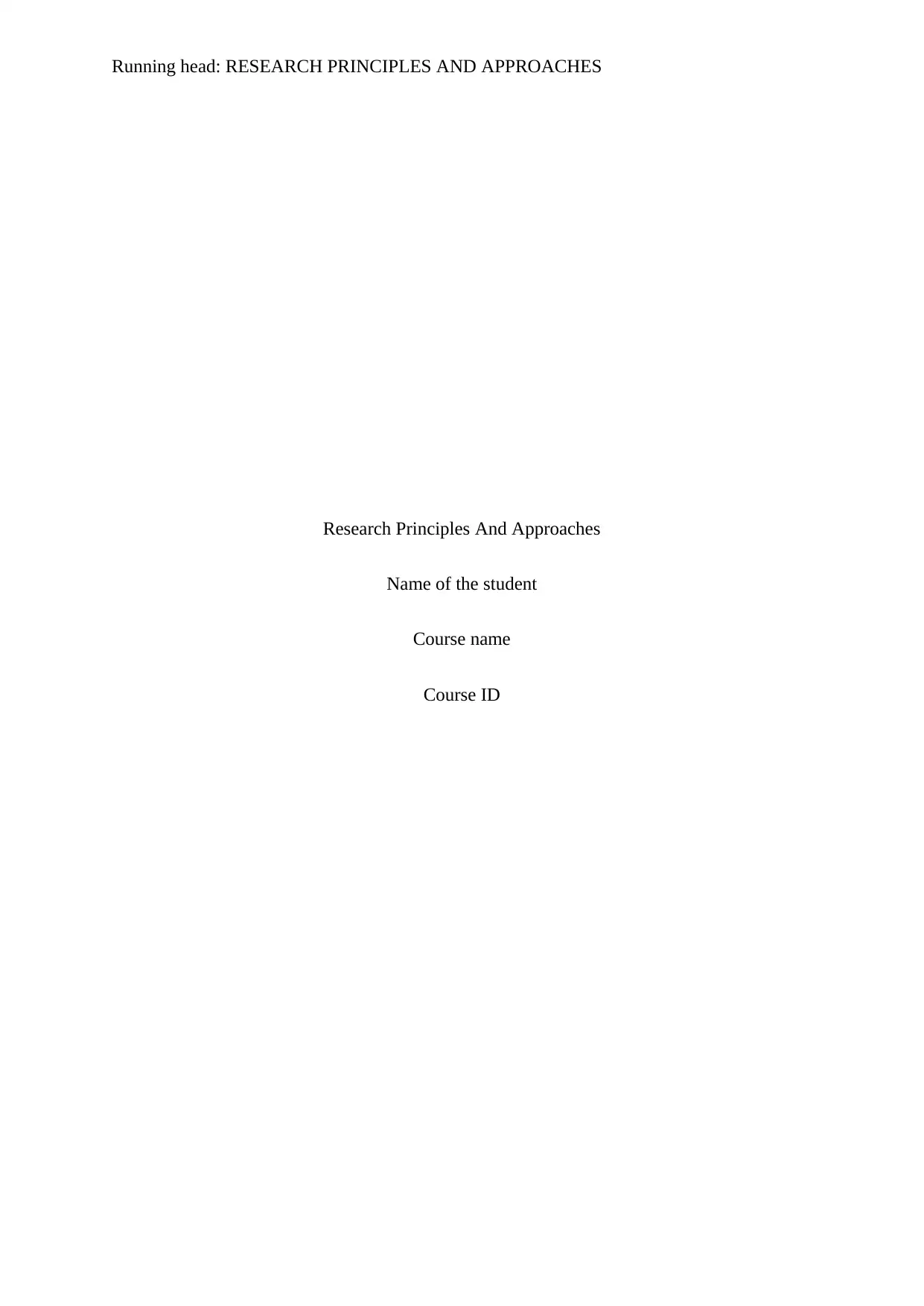
Running head: RESEARCH PRINCIPLES AND APPROACHES
Research Principles And Approaches
Name of the student
Course name
Course ID
Research Principles And Approaches
Name of the student
Course name
Course ID
Paraphrase This Document
Need a fresh take? Get an instant paraphrase of this document with our AI Paraphraser
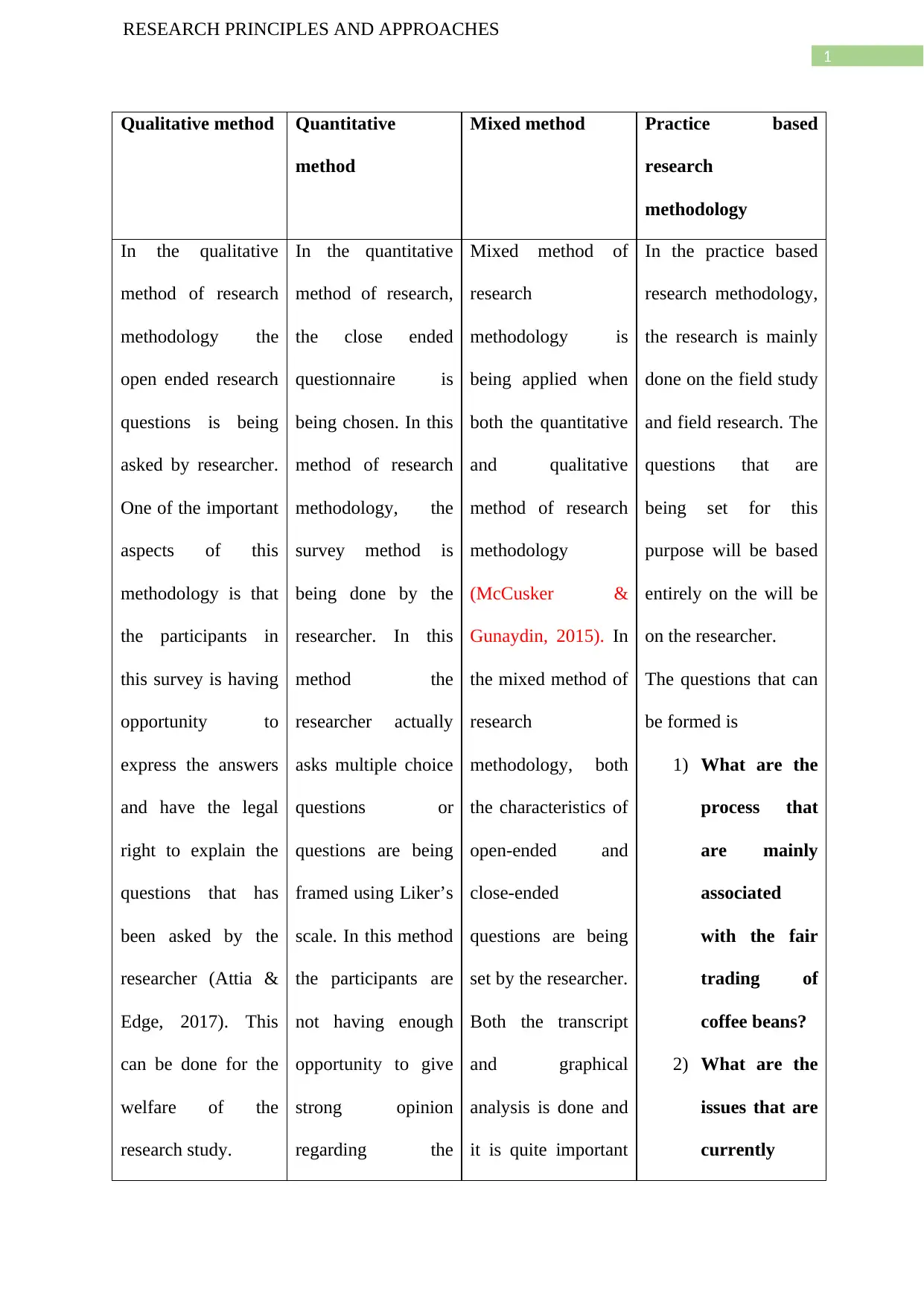
1
RESEARCH PRINCIPLES AND APPROACHES
Qualitative method Quantitative
method
Mixed method Practice based
research
methodology
In the qualitative
method of research
methodology the
open ended research
questions is being
asked by researcher.
One of the important
aspects of this
methodology is that
the participants in
this survey is having
opportunity to
express the answers
and have the legal
right to explain the
questions that has
been asked by the
researcher (Attia &
Edge, 2017). This
can be done for the
welfare of the
research study.
In the quantitative
method of research,
the close ended
questionnaire is
being chosen. In this
method of research
methodology, the
survey method is
being done by the
researcher. In this
method the
researcher actually
asks multiple choice
questions or
questions are being
framed using Liker’s
scale. In this method
the participants are
not having enough
opportunity to give
strong opinion
regarding the
Mixed method of
research
methodology is
being applied when
both the quantitative
and qualitative
method of research
methodology
(McCusker &
Gunaydin, 2015). In
the mixed method of
research
methodology, both
the characteristics of
open-ended and
close-ended
questions are being
set by the researcher.
Both the transcript
and graphical
analysis is done and
it is quite important
In the practice based
research methodology,
the research is mainly
done on the field study
and field research. The
questions that are
being set for this
purpose will be based
entirely on the will be
on the researcher.
The questions that can
be formed is
1) What are the
process that
are mainly
associated
with the fair
trading of
coffee beans?
2) What are the
issues that are
currently
RESEARCH PRINCIPLES AND APPROACHES
Qualitative method Quantitative
method
Mixed method Practice based
research
methodology
In the qualitative
method of research
methodology the
open ended research
questions is being
asked by researcher.
One of the important
aspects of this
methodology is that
the participants in
this survey is having
opportunity to
express the answers
and have the legal
right to explain the
questions that has
been asked by the
researcher (Attia &
Edge, 2017). This
can be done for the
welfare of the
research study.
In the quantitative
method of research,
the close ended
questionnaire is
being chosen. In this
method of research
methodology, the
survey method is
being done by the
researcher. In this
method the
researcher actually
asks multiple choice
questions or
questions are being
framed using Liker’s
scale. In this method
the participants are
not having enough
opportunity to give
strong opinion
regarding the
Mixed method of
research
methodology is
being applied when
both the quantitative
and qualitative
method of research
methodology
(McCusker &
Gunaydin, 2015). In
the mixed method of
research
methodology, both
the characteristics of
open-ended and
close-ended
questions are being
set by the researcher.
Both the transcript
and graphical
analysis is done and
it is quite important
In the practice based
research methodology,
the research is mainly
done on the field study
and field research. The
questions that are
being set for this
purpose will be based
entirely on the will be
on the researcher.
The questions that can
be formed is
1) What are the
process that
are mainly
associated
with the fair
trading of
coffee beans?
2) What are the
issues that are
currently
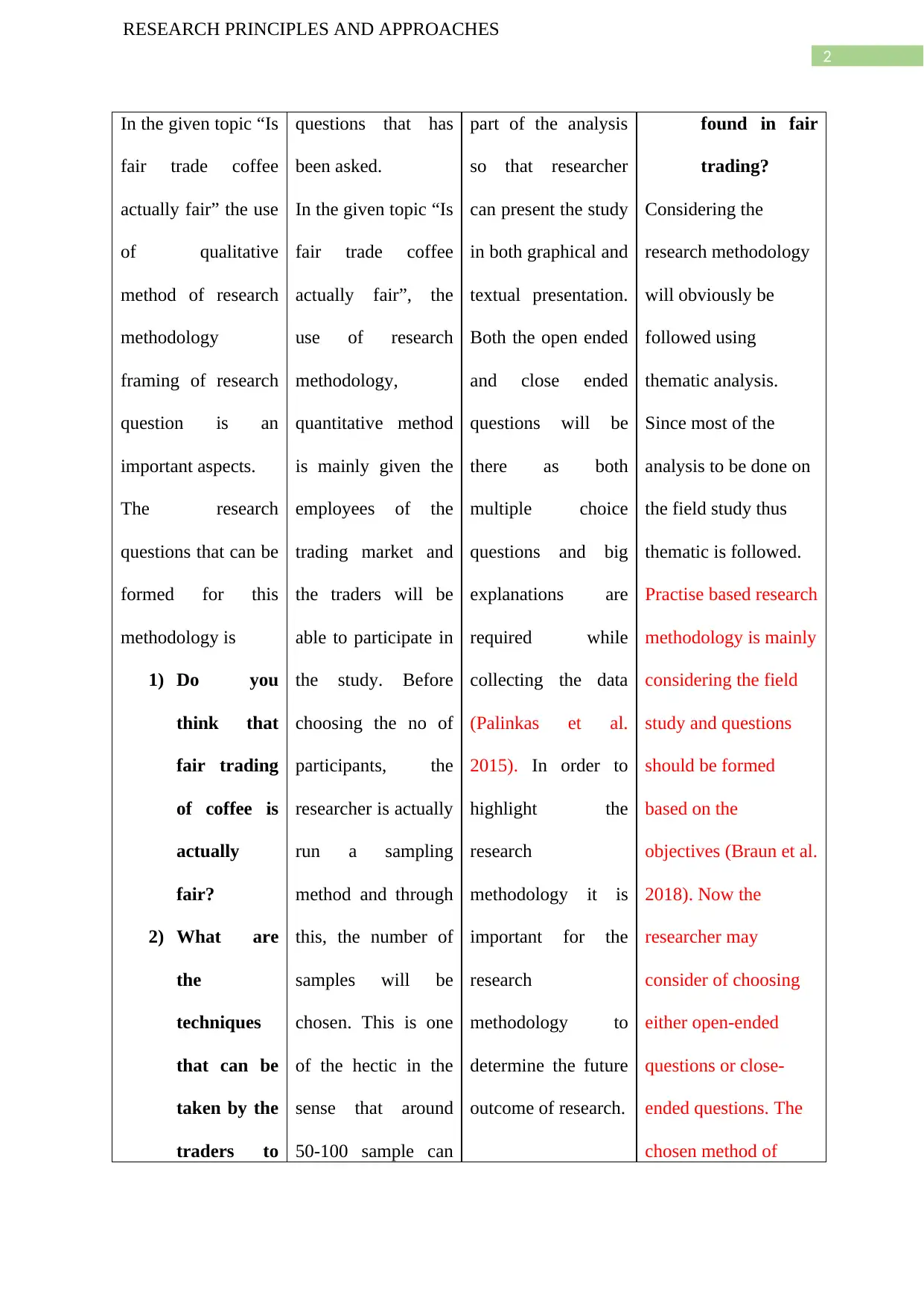
2
RESEARCH PRINCIPLES AND APPROACHES
In the given topic “Is
fair trade coffee
actually fair” the use
of qualitative
method of research
methodology
framing of research
question is an
important aspects.
The research
questions that can be
formed for this
methodology is
1) Do you
think that
fair trading
of coffee is
actually
fair?
2) What are
the
techniques
that can be
taken by the
traders to
questions that has
been asked.
In the given topic “Is
fair trade coffee
actually fair”, the
use of research
methodology,
quantitative method
is mainly given the
employees of the
trading market and
the traders will be
able to participate in
the study. Before
choosing the no of
participants, the
researcher is actually
run a sampling
method and through
this, the number of
samples will be
chosen. This is one
of the hectic in the
sense that around
50-100 sample can
part of the analysis
so that researcher
can present the study
in both graphical and
textual presentation.
Both the open ended
and close ended
questions will be
there as both
multiple choice
questions and big
explanations are
required while
collecting the data
(Palinkas et al.
2015). In order to
highlight the
research
methodology it is
important for the
research
methodology to
determine the future
outcome of research.
found in fair
trading?
Considering the
research methodology
will obviously be
followed using
thematic analysis.
Since most of the
analysis to be done on
the field study thus
thematic is followed.
Practise based research
methodology is mainly
considering the field
study and questions
should be formed
based on the
objectives (Braun et al.
2018). Now the
researcher may
consider of choosing
either open-ended
questions or close-
ended questions. The
chosen method of
RESEARCH PRINCIPLES AND APPROACHES
In the given topic “Is
fair trade coffee
actually fair” the use
of qualitative
method of research
methodology
framing of research
question is an
important aspects.
The research
questions that can be
formed for this
methodology is
1) Do you
think that
fair trading
of coffee is
actually
fair?
2) What are
the
techniques
that can be
taken by the
traders to
questions that has
been asked.
In the given topic “Is
fair trade coffee
actually fair”, the
use of research
methodology,
quantitative method
is mainly given the
employees of the
trading market and
the traders will be
able to participate in
the study. Before
choosing the no of
participants, the
researcher is actually
run a sampling
method and through
this, the number of
samples will be
chosen. This is one
of the hectic in the
sense that around
50-100 sample can
part of the analysis
so that researcher
can present the study
in both graphical and
textual presentation.
Both the open ended
and close ended
questions will be
there as both
multiple choice
questions and big
explanations are
required while
collecting the data
(Palinkas et al.
2015). In order to
highlight the
research
methodology it is
important for the
research
methodology to
determine the future
outcome of research.
found in fair
trading?
Considering the
research methodology
will obviously be
followed using
thematic analysis.
Since most of the
analysis to be done on
the field study thus
thematic is followed.
Practise based research
methodology is mainly
considering the field
study and questions
should be formed
based on the
objectives (Braun et al.
2018). Now the
researcher may
consider of choosing
either open-ended
questions or close-
ended questions. The
chosen method of
⊘ This is a preview!⊘
Do you want full access?
Subscribe today to unlock all pages.

Trusted by 1+ million students worldwide
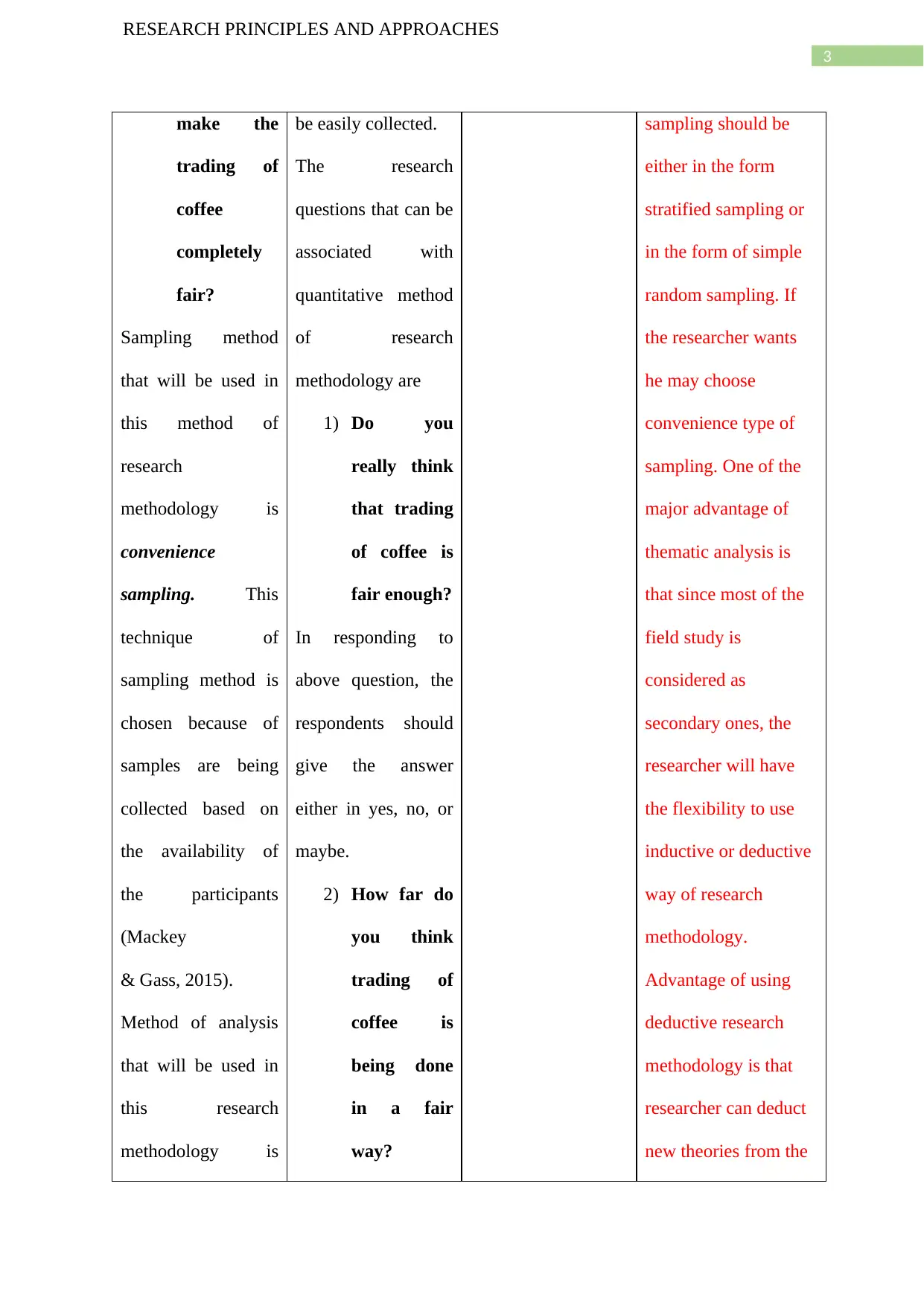
3
RESEARCH PRINCIPLES AND APPROACHES
make the
trading of
coffee
completely
fair?
Sampling method
that will be used in
this method of
research
methodology is
convenience
sampling. This
technique of
sampling method is
chosen because of
samples are being
collected based on
the availability of
the participants
(Mackey
& Gass, 2015).
Method of analysis
that will be used in
this research
methodology is
be easily collected.
The research
questions that can be
associated with
quantitative method
of research
methodology are
1) Do you
really think
that trading
of coffee is
fair enough?
In responding to
above question, the
respondents should
give the answer
either in yes, no, or
maybe.
2) How far do
you think
trading of
coffee is
being done
in a fair
way?
sampling should be
either in the form
stratified sampling or
in the form of simple
random sampling. If
the researcher wants
he may choose
convenience type of
sampling. One of the
major advantage of
thematic analysis is
that since most of the
field study is
considered as
secondary ones, the
researcher will have
the flexibility to use
inductive or deductive
way of research
methodology.
Advantage of using
deductive research
methodology is that
researcher can deduct
new theories from the
RESEARCH PRINCIPLES AND APPROACHES
make the
trading of
coffee
completely
fair?
Sampling method
that will be used in
this method of
research
methodology is
convenience
sampling. This
technique of
sampling method is
chosen because of
samples are being
collected based on
the availability of
the participants
(Mackey
& Gass, 2015).
Method of analysis
that will be used in
this research
methodology is
be easily collected.
The research
questions that can be
associated with
quantitative method
of research
methodology are
1) Do you
really think
that trading
of coffee is
fair enough?
In responding to
above question, the
respondents should
give the answer
either in yes, no, or
maybe.
2) How far do
you think
trading of
coffee is
being done
in a fair
way?
sampling should be
either in the form
stratified sampling or
in the form of simple
random sampling. If
the researcher wants
he may choose
convenience type of
sampling. One of the
major advantage of
thematic analysis is
that since most of the
field study is
considered as
secondary ones, the
researcher will have
the flexibility to use
inductive or deductive
way of research
methodology.
Advantage of using
deductive research
methodology is that
researcher can deduct
new theories from the
Paraphrase This Document
Need a fresh take? Get an instant paraphrase of this document with our AI Paraphraser
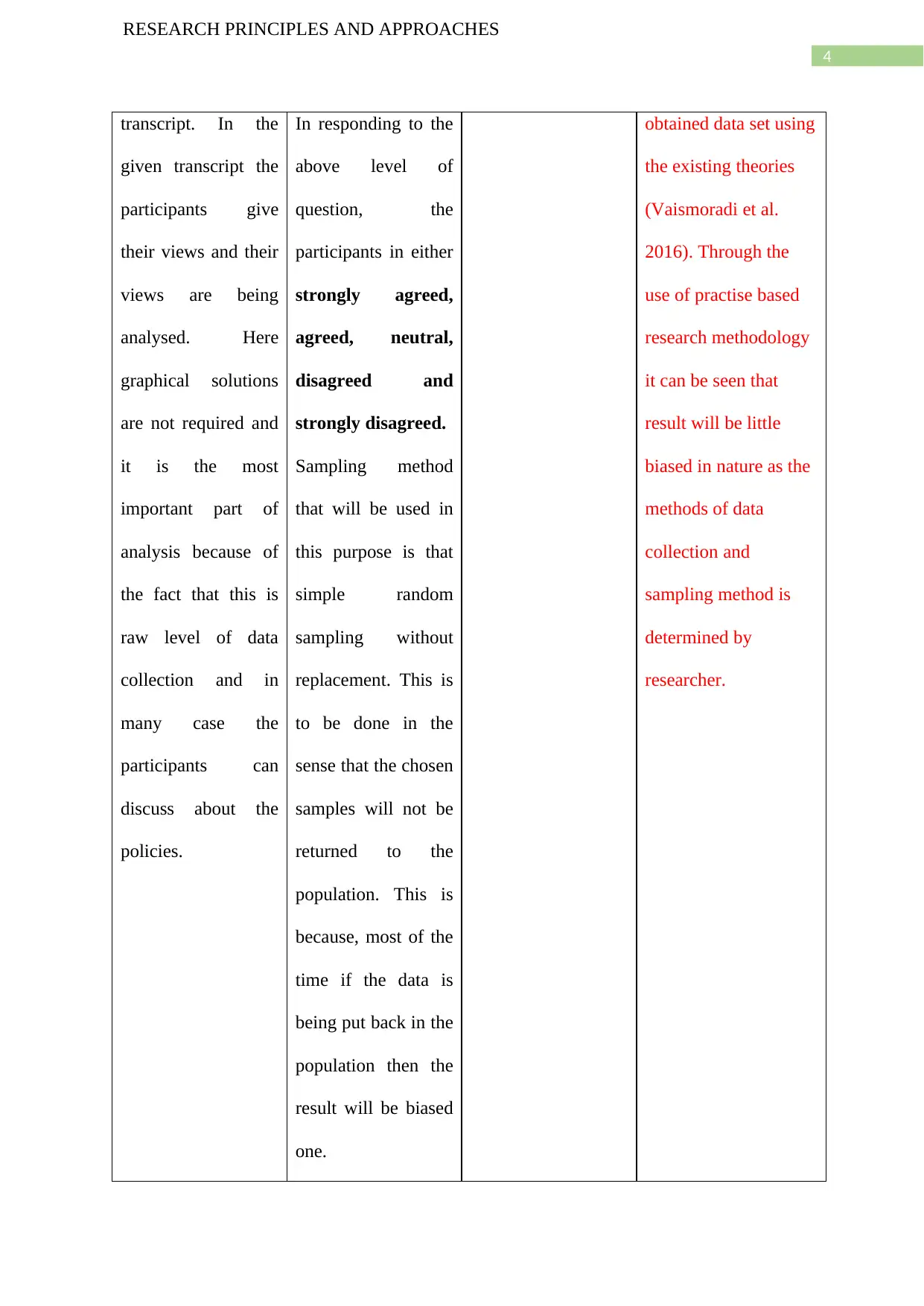
4
RESEARCH PRINCIPLES AND APPROACHES
transcript. In the
given transcript the
participants give
their views and their
views are being
analysed. Here
graphical solutions
are not required and
it is the most
important part of
analysis because of
the fact that this is
raw level of data
collection and in
many case the
participants can
discuss about the
policies.
In responding to the
above level of
question, the
participants in either
strongly agreed,
agreed, neutral,
disagreed and
strongly disagreed.
Sampling method
that will be used in
this purpose is that
simple random
sampling without
replacement. This is
to be done in the
sense that the chosen
samples will not be
returned to the
population. This is
because, most of the
time if the data is
being put back in the
population then the
result will be biased
one.
obtained data set using
the existing theories
(Vaismoradi et al.
2016). Through the
use of practise based
research methodology
it can be seen that
result will be little
biased in nature as the
methods of data
collection and
sampling method is
determined by
researcher.
RESEARCH PRINCIPLES AND APPROACHES
transcript. In the
given transcript the
participants give
their views and their
views are being
analysed. Here
graphical solutions
are not required and
it is the most
important part of
analysis because of
the fact that this is
raw level of data
collection and in
many case the
participants can
discuss about the
policies.
In responding to the
above level of
question, the
participants in either
strongly agreed,
agreed, neutral,
disagreed and
strongly disagreed.
Sampling method
that will be used in
this purpose is that
simple random
sampling without
replacement. This is
to be done in the
sense that the chosen
samples will not be
returned to the
population. This is
because, most of the
time if the data is
being put back in the
population then the
result will be biased
one.
obtained data set using
the existing theories
(Vaismoradi et al.
2016). Through the
use of practise based
research methodology
it can be seen that
result will be little
biased in nature as the
methods of data
collection and
sampling method is
determined by
researcher.

5
RESEARCH PRINCIPLES AND APPROACHES
RESEARCH PRINCIPLES AND APPROACHES
⊘ This is a preview!⊘
Do you want full access?
Subscribe today to unlock all pages.

Trusted by 1+ million students worldwide
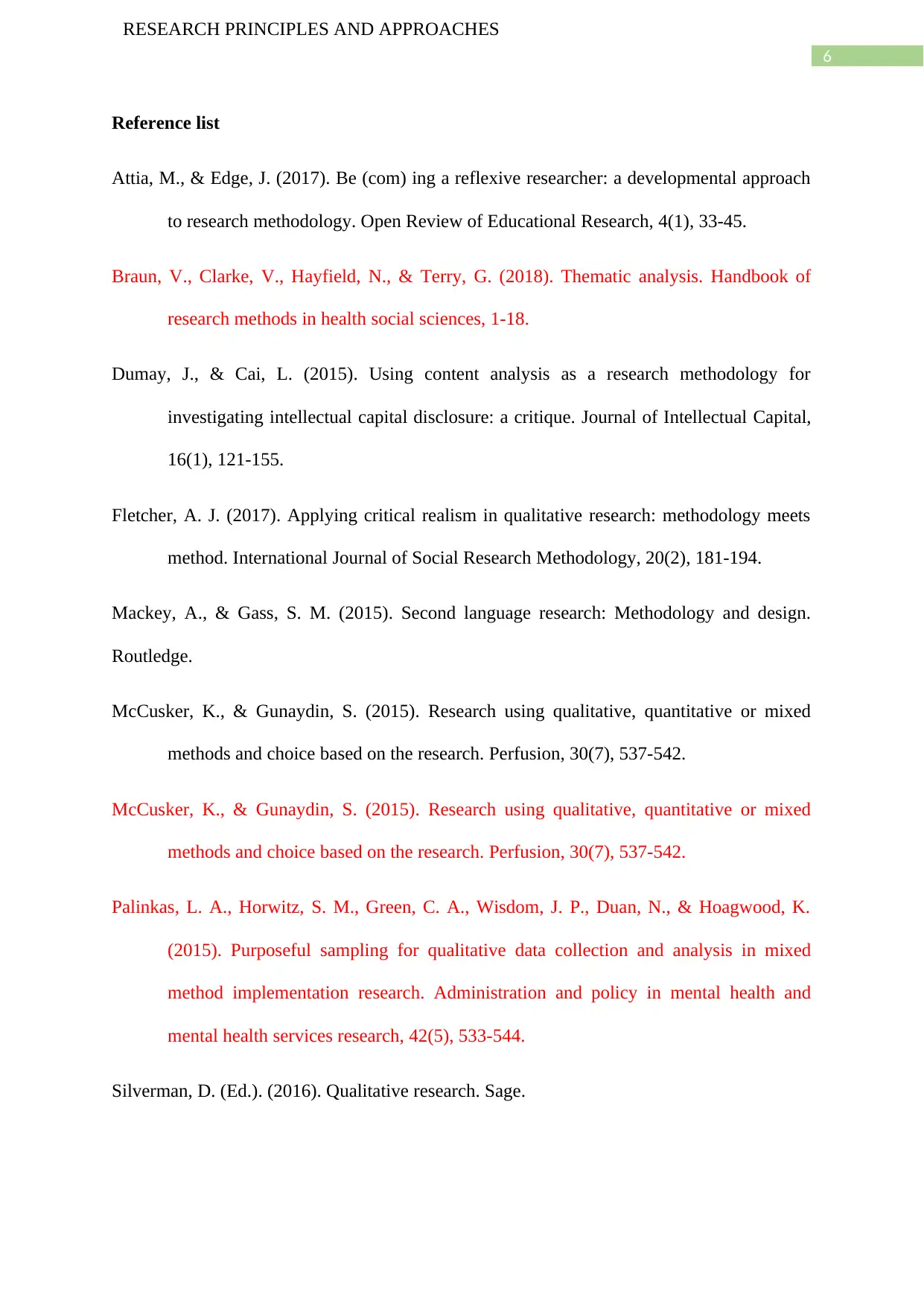
6
RESEARCH PRINCIPLES AND APPROACHES
Reference list
Attia, M., & Edge, J. (2017). Be (com) ing a reflexive researcher: a developmental approach
to research methodology. Open Review of Educational Research, 4(1), 33-45.
Braun, V., Clarke, V., Hayfield, N., & Terry, G. (2018). Thematic analysis. Handbook of
research methods in health social sciences, 1-18.
Dumay, J., & Cai, L. (2015). Using content analysis as a research methodology for
investigating intellectual capital disclosure: a critique. Journal of Intellectual Capital,
16(1), 121-155.
Fletcher, A. J. (2017). Applying critical realism in qualitative research: methodology meets
method. International Journal of Social Research Methodology, 20(2), 181-194.
Mackey, A., & Gass, S. M. (2015). Second language research: Methodology and design.
Routledge.
McCusker, K., & Gunaydin, S. (2015). Research using qualitative, quantitative or mixed
methods and choice based on the research. Perfusion, 30(7), 537-542.
McCusker, K., & Gunaydin, S. (2015). Research using qualitative, quantitative or mixed
methods and choice based on the research. Perfusion, 30(7), 537-542.
Palinkas, L. A., Horwitz, S. M., Green, C. A., Wisdom, J. P., Duan, N., & Hoagwood, K.
(2015). Purposeful sampling for qualitative data collection and analysis in mixed
method implementation research. Administration and policy in mental health and
mental health services research, 42(5), 533-544.
Silverman, D. (Ed.). (2016). Qualitative research. Sage.
RESEARCH PRINCIPLES AND APPROACHES
Reference list
Attia, M., & Edge, J. (2017). Be (com) ing a reflexive researcher: a developmental approach
to research methodology. Open Review of Educational Research, 4(1), 33-45.
Braun, V., Clarke, V., Hayfield, N., & Terry, G. (2018). Thematic analysis. Handbook of
research methods in health social sciences, 1-18.
Dumay, J., & Cai, L. (2015). Using content analysis as a research methodology for
investigating intellectual capital disclosure: a critique. Journal of Intellectual Capital,
16(1), 121-155.
Fletcher, A. J. (2017). Applying critical realism in qualitative research: methodology meets
method. International Journal of Social Research Methodology, 20(2), 181-194.
Mackey, A., & Gass, S. M. (2015). Second language research: Methodology and design.
Routledge.
McCusker, K., & Gunaydin, S. (2015). Research using qualitative, quantitative or mixed
methods and choice based on the research. Perfusion, 30(7), 537-542.
McCusker, K., & Gunaydin, S. (2015). Research using qualitative, quantitative or mixed
methods and choice based on the research. Perfusion, 30(7), 537-542.
Palinkas, L. A., Horwitz, S. M., Green, C. A., Wisdom, J. P., Duan, N., & Hoagwood, K.
(2015). Purposeful sampling for qualitative data collection and analysis in mixed
method implementation research. Administration and policy in mental health and
mental health services research, 42(5), 533-544.
Silverman, D. (Ed.). (2016). Qualitative research. Sage.
Paraphrase This Document
Need a fresh take? Get an instant paraphrase of this document with our AI Paraphraser

7
RESEARCH PRINCIPLES AND APPROACHES
Vaismoradi, M., Jones, J., Turunen, H., & Snelgrove, S. (2016). Theme development in
qualitative content analysis and thematic analysis.
Walliman, N. (2017). Research methods: The basics. Routledge.
Wildemuth, B. M. (Ed.). (2016). Applications of social research methods to questions in
information and library science. ABC-CLIO.
RESEARCH PRINCIPLES AND APPROACHES
Vaismoradi, M., Jones, J., Turunen, H., & Snelgrove, S. (2016). Theme development in
qualitative content analysis and thematic analysis.
Walliman, N. (2017). Research methods: The basics. Routledge.
Wildemuth, B. M. (Ed.). (2016). Applications of social research methods to questions in
information and library science. ABC-CLIO.
1 out of 8
Related Documents
Your All-in-One AI-Powered Toolkit for Academic Success.
+13062052269
info@desklib.com
Available 24*7 on WhatsApp / Email
![[object Object]](/_next/static/media/star-bottom.7253800d.svg)
Unlock your academic potential
Copyright © 2020–2025 A2Z Services. All Rights Reserved. Developed and managed by ZUCOL.





